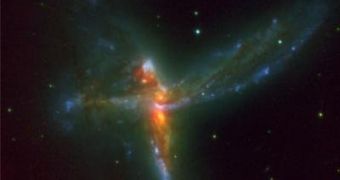The merging galaxy system also known as the 'Tinker Bell' belongs to a special class of interacting galaxies glowing brightly in the infrared spectrum. Previously thought to be formed of two colliding galaxies, one of an irregular shape and the second, a typical barrel spiral shaped galaxy similar to our own, 'The Bird' clearly reveals the presence of a third interacting body, part of the irregular galaxy traveling at impressive speeds away from the system.
Situated at more than 650 million light years away from Earth, the galaxy system ESO 593-IG 008 represents one of the rarest types of galaxy interaction, since triple mergers are relatively scarce in the visible universe. Nevertheless, ESO's VTL revealed what previously seemed like an irregular galaxy, the presence of two separate objects.
The bird-like formation, which gave the system's nickname, is constituted by two wing-like features created by gravitational tidal interactions, a so-called 'body' represented by the irregular shaped galaxy, and the 'head', being the newly discovered galaxy, together forming a structure stretching more than 100,000 light years into space, equivalent to the diameter of the Milky Way.
The discovery of the VLT was soon confirmed by the Spitzer infrared space telescope, and further revealed that the newly discovered structure was also moving apart from the system at a speed exceeding 400 kilometers per seconds, which is extremely rare in the case of merging galaxy structures.
The system formed through the collision of three separate galaxies is thought to be more than a few hundred million years old, and its bright infrared emission seems to originate in the newly discovered galaxy, evidence that it is actively producing stars, possibly at a rate of 200 stars per year, while its companions are relatively inactive. Such merging event is thought to be one of the stages of galaxy evolution and will probably determine a new star formation process in the whole structure, and eventually the formation of a single object, which will most probably be an elliptical galaxy.

 14 DAY TRIAL //
14 DAY TRIAL //